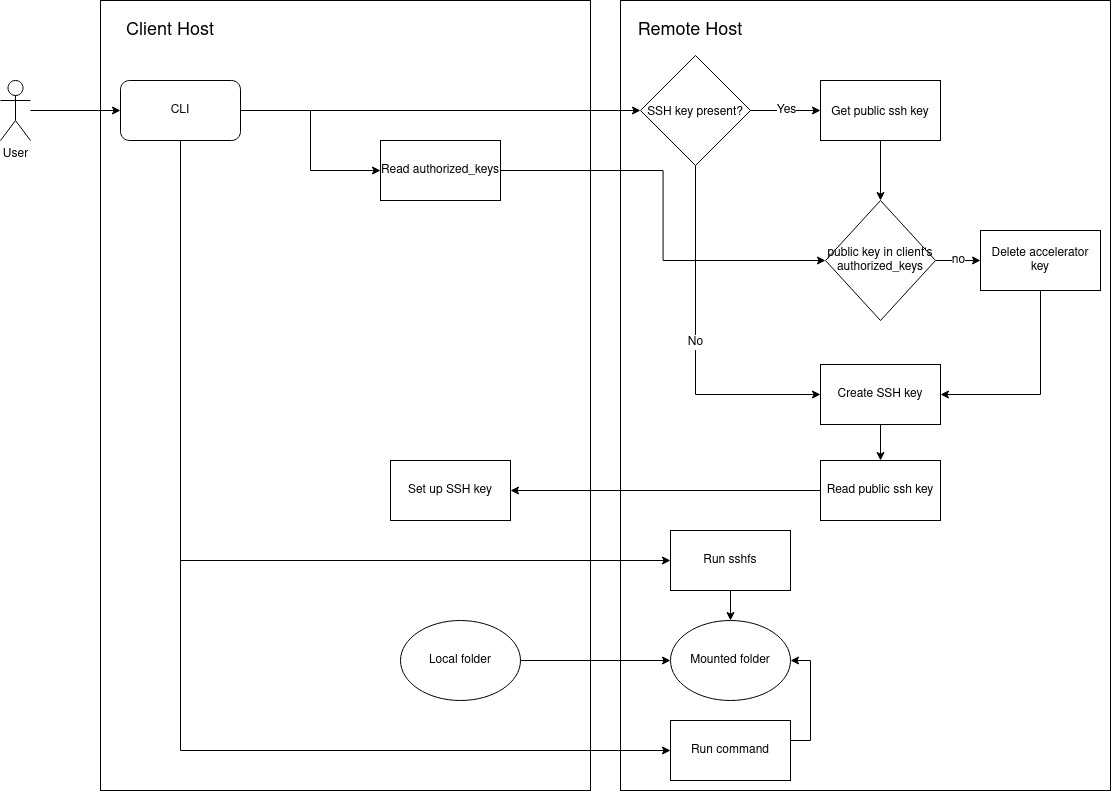Accelerator¶
The accelerator script is a simple script meant to make it easy for anyone to run commands on a remote host on which is mounted (via sshfs) a specified folder.
This script takes as input a configuration file specifying which one or multiple hosts on which to mount the specified folder and run the given command. This configuration file follows the same structure and requirements as the rest of remote_builder.
How does it work?¶
Workflow¶
The accelerator works in the following way:
- Two SSH sessions are opened between the client and the remote host.
- Using one of these two session, check if the remote host has an
acceleratororaccelerator.pubfile in its home directory (which are the private and public ssh keys the accelerator script would have created if it had been run before) - If either file exists, read the
accelerator.pubfile - Read the public keys set in
~/.ssh/authorized_keysfile - Check if the content of
accelerator.pubis in~/.ssh/authorized_keys, if that’s the case we continue, otherwise theacceleratorandaccelerator.pubfiles are deleted on the remote host. - If no
acceleratororaccelerator.pubfile were found on the remote host, or if they were deleted, a SSH key is created on the remote host (under files namedacceleratorfor the private key andaccelerator.pubfor the public key) - If the SSH key was created, it is then set up in
~/.ssh/authorized_keyson the client.
All of the steps until now were done to allow the remote host to connect to the client using a SSH key, in such a way that the key isn’t re-generated every time the accelerator is ran.
The next two steps are the core of what the program does:
- One of the two session is then used to start and run a sshfs session which mounts from the client to the remote host the folder specified in the CLI arguments.
- The second SSH session is then used to run the specified command on the remote host, in the folder mounted from the client. The output of the command sent back to the client where it is shown live.
Workflow diagram¶
As the saying goes: a picture is worth a thousand words, so here is a workflow diagram of the application.

Assumptions¶
To make this script work, a number of assumptions have been made:
- A SSH connection can be established between the two hosts.
- On the client: sshd is running and configured to accept ssh-key based SSH session.
- On the client: SSH is configured to accept SSHFS connection from the remote
host (this may require enabling the sftp subsystem in
/etc/ssh/sshd_config). - On the remote host: SSHFS is installed. In Fedora and CentOS-stream it is
provided by the
fuse-sshfspackage (available in EPEL). - On the remote host: SSHFS is configured to allow mounting a folder from a
different user. This is achieved by having
user_allow_otherin/etc/fuse.conf.